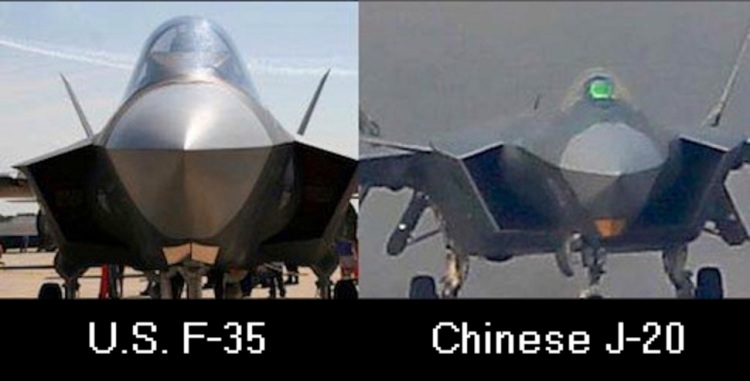Chinese J-20 stealth fighter incorporates F-35 secrets stolen from U.S.
Bill Gertz reports for The Washington Free Beacon, March 13, 2014:
A cyber espionage operation by China seven years ago produced sensitive technology and aircraft secrets that were incorporated into the latest version of China’s new J-20 stealth fighter jet, according to U.S. officials and private defense analysts.
The Chinese cyber spying against the Lockheed Martin F-35 Lightning II took place in 2007 under what U.S. intelligence agencies codenamedOperation Byzantine Hades, a large-scale, multi-year cyber programthat targeted governments and industry.
Defense officials said the stolen data was obtained by a Chinese military unit called a Technical Reconnaissance Bureau in the Chengdu province. The data was then passed to the state-run Aviation Industry Corp. of China (AVIC).
An AVIC subsidiary, the Chengdu Aircraft Industry Group, used the stolen data in building the J-20, said defense and intelligence officials familiar with reports of the illicit tech transfer.
Pentagon technology security officials in 2011 opposed a joint venture between General Electric and AVIC over concerns that U.S. fighter jet technology would be diverted to AVIC’s military aircraft programs. The Obama administration ignored the concerns and instead has since promoted the systematic loosening of technology controls on transfers to China.
The Office of Director of National Intelligence is known to have details of AVIC’s past involvement in illicit arms transfers and its role in obtaining sensitive F-35 technology through cyber espionage, the officials said.
The F-35 data theft was confirmed after recent photographs were published onChinese websites showing a newer version of the J-20. The new version of the radar-evading aircraft had incorporated several design upgradessince the first demonstrator aircraft was revealed in 2011.
According to the officials, the J-20 has progressed from prototype to demonstrator. One of its most significant weapons enhancements is a new electro-optical targeting system under its nose.
Additionally, protruding engine nozzles seen in the earlier version have been hidden, an attempt to further reduce the jet’s radar signature. The newest J-20 also appeared with a different radar-absorbing coating.
Photos of the newer J-20 were first posted online on Chinese military forums on Jan. 17.
The Pentagon’s Defense Science Board revealed earlier this year that system design information on the F-35 was obtained from cyber attacks.
The new Terminal High Altitude Area Defense missile systems and Patriot Advanced Capability-3 (PAC-3) missile defenses, along with many other systems, were compromised through cyber espionage, the board said in a report.
Most details of the Chinese cyber espionage campaign to obtain F-35 technology remain secret.
However, the Chinese probably obtained the F-35 secrets from Lockheed Martin, its subcontractors, or U.S. allies involved in the development program. Allies that took part in the F-35 program include the United Kingdom, Israel, Italy, Australia, Canada, Norway, Denmark, the Netherlands, and Turkey.
A Chinese Academy of Military Sciences official, Du Wenlong, told Chinese state television on Feb. 20 that the new J-20’s shortened exhaust nozzles, along with tail and vertical fin modifications, are designed to reduce radar detection.
Du also said that a “revolutionary” breakthrough allowed the twin engines to increase both power and reliability.
China’s inability to manufacture quality jet engines has been a weakness of its aircraft manufacturing programs.
Du also said that the electro-optical targeting system provides better surveillance and strike capabilities against both land and sea targets.
The J-20 also has a larger weapons bay than the U.S. F-22, which allows it to carry more powerful missiles that can be used against “aircraft carrier and foreign AEGIS ships,” Du said.
U.S. officials said the new J-20 had undergone ground tests, but it had not been flight tested as of early March.
Richard Fisher, a specialist on Chinese weapon systems, said the new J-20 was flight tested on March 1 and demonstrated the enhanced fifth generation jet fighter features.
Fisher, with the International Assessment and Strategy Center, said it is “very curious” that the new J-20 featured its new electronic targeting system under its nose. That location increased its field of view and is similar to the targeting system on the F-35.
“This targeting system and a set of distributed high-power infrared sensors give the F-35 a previously unrivaled ‘situational awareness,’ but the now it is clear that the J-20 will have a similar targeting system and its own set of distributed sensors,” Fisher said.
“If as part of their espionage, China had also gained engineering insights into the F-35′s very advanced sensor systems, that could prove disastrous to its combat potential barring a rapid redesign and improvements before entering service,” Fisher added.
Advanced sensors on the F-35 were intended as insurance for the jet not having the best capabilities for maneuvering in flight, he said.
“But if the Chinese, via cyberespionage, have gained insights into its sensor system, then it is to be expected that China is also working on ways to jam or otherwise degrade its advantage,” Fisher said.
The J-20 targeting system indicates that the Chinese plan to use the jet for ground attack and air superiority missions like the F-35, he said, adding that it now appears the J-20 will be comparable to the more capable F-22.
“We can be assured that J-20 production will significantly exceed that of the 187 F-22 fighters cut off by the Obama Administration in 2010,” he said.
China’s Communist Party-affiliated Global Times reported Jan. 20 that China obtained key technologies from the F-35 and incorporated them into the J-20.
The newspaper did not admit stealing the technology, but stated that China “completely obtained the six key technologies” from the F-35.
Those features include the electro-optical targeting system and a diverterless supersonic inlet, a thrust-vectoring jet nozzle, and a fire-control array radar system.
The Global Times disclosures about F-35 technology acquisition were first reported in the Washington Times.

No comments:
Post a Comment
Comments always welcome!